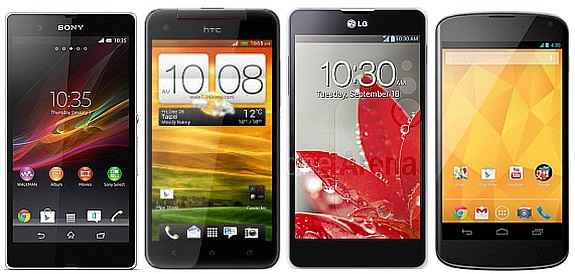Android Flagship Fight: Sony Xperia Z vs. LG Optimus G vs. Nexus 4 vs. HTC Butterfly
2013 has just begun and we have started seeing the launch of quite a few flagship smartphones in India. We compare the recently launched LG Optimus G, Sony Xperia Z and the HTC Butterfly with the Nexus 4.
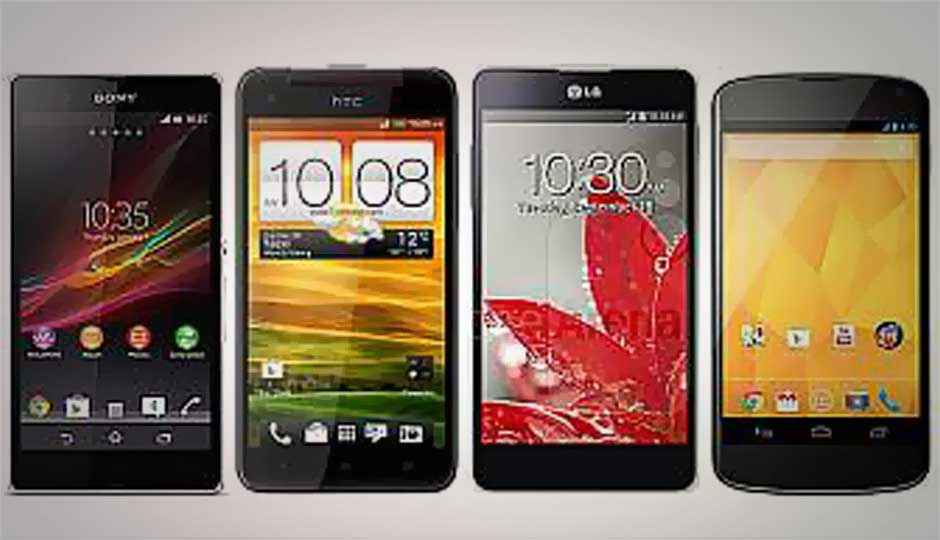
If you are in the market today to pick up a new flagship smartphone, you are in luck. In the past month we have seen the launch of smartphones such as the HTC Butterfly, Sony Xperia Z, and LG Optimus G.
 Survey
SurveyAll these smartphones are the crème de la crème of their respective manufacturers. The only common thing between these devices is that they run on the Android OS. But each manufacturer has added their own variant of a skin on the OS. The skin brings with it a slew of features to the smartphone. The hardware specifications of these devices, of course, also vary.
Making a purchase decision of your next flagship smartphone depends on a number of factors. To start with the brand of the smartphone maker is very important especially in a brand conscious country like India. People who care more about the performance than brand will do their homework and pick up a smartphone that has not only the best specifications but also the best benchmark scores of the lot. Some smartphones bring with them a slew of features that enhance the smartphone experience. These features may be as simple as voice commands or multi-window or a skin/theme that adds more information to your home screen. Whatever the reason, here we take a look at the recently launched flagship smartphones in India and tell you the features and performance value that each brings to the table.
Specifications Comparison
Let us start with the specifications of the four smartphones. The prices of these smartphones ranges from a mere Rs. 25,000 for the Nexus 4 (which unfortunately isn’t officially available in India), to the HTC Butterfly which is priced at Rs. 43,000, making it one of the most expensive flagship smartphones we have seen till date.
|
Model
|
LG Optimus G E975
|
LG Google Nexus 4
|
HTC Butterfly
|
Sony Xperia Z
|
|
Approx. market price
|
Rs. 30,990
|
Not officially in India. Rs 25,000 approx from U.S.
|
Rs. 43,000
|
Rs. 38,990
|
|
SoC
|
Qualcomm APQ8064 Snapdragon
|
Qualcomm APQ8064 Snapdragon
|
Qualcomm APQ8064 Snapdragon
|
Qualcomm APQ8064 Snapdragon
|
|
Cores
|
4
|
4
|
4
|
4
|
|
Clock Speed (GHz)
|
1.5
|
1.5
|
1.5
|
1.5
|
|
RAM (GB)
|
2
|
2
|
2
|
2
|
|
Display Size
|
4.7
|
4.7
|
5
|
5
|
|
Display resolution (pixels)
|
1280 x 768
|
1280 x 768
|
1920 x 1080
|
1920 x 1080
|
|
Display type
|
IPS Plus LCD
|
IPS Plus LCD
|
S-LCD3
|
LCD – Reality Display
|
|
Pixel density (Ppi)
|
318
|
318
|
441
|
443
|
|
Graphics
|
Adreno 320
|
Adreno 320
|
Adreno 320
|
Adreno 320
|
|
Internal Storage
|
32GB
|
8GB / 16GB
|
16GB
|
16GB
|
|
Expandable memory?
|
No
|
No
|
Yes
|
Yes
|
|
Primary Camera
|
13MP
|
8MP
|
8MP
|
13.1MP
|
|
Battery
|
2100mAh
|
2100mAh
|
2020mAh
|
2330mAh
|
|
Platform
|
Android 4.1.2 (Jelly Bean)
|
Android 4.2.1 (Jelly Bean)
|
Android 4.1.1 (Jelly Bean)
|
Android 4.1.2 (Jelly Bean)
|
All the smartphones boast of a quad-core CPU clocked at 1.5GHz with 2GB of RAM. The LG Optimus G and the Nexus 4 have a 720p HD display sized at 4.7-inches whereas the HTC Butterfly and the Sony Xperia Z have a full HD 1080p display sized at 5-inches. The Butterfly has the smallest battery capacity at 2020mAh whereas the Xperia Z has the largest battery at 2330mAh.
Performance Comparison
The specifications of all the smartphones may be nearly at par, but it is the optimization and the benchmark scores which tell us the true raw performance of these devices.
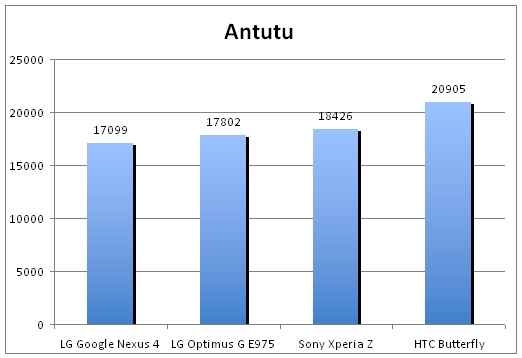 |
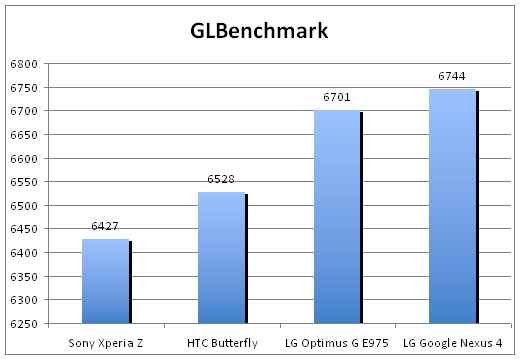 |
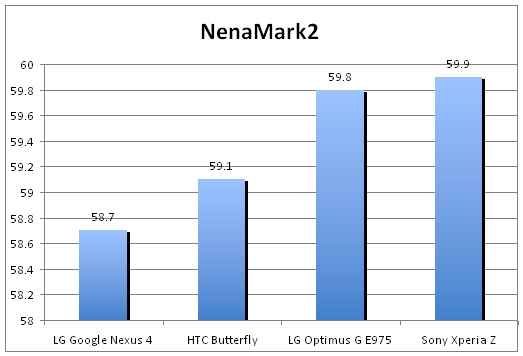 |
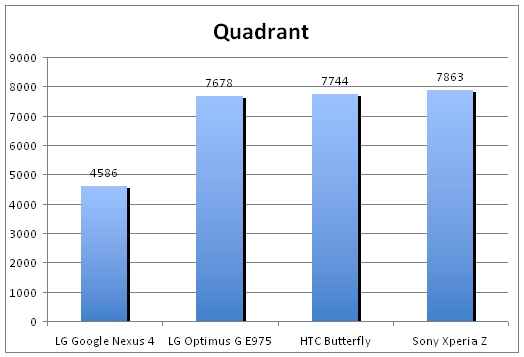 |
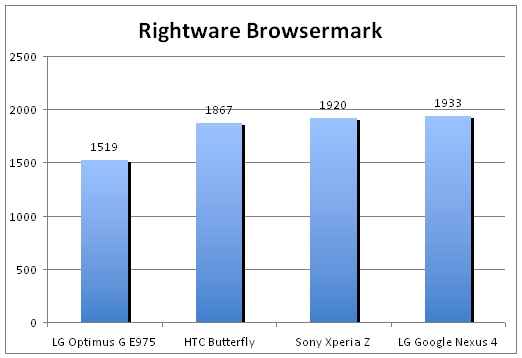 |
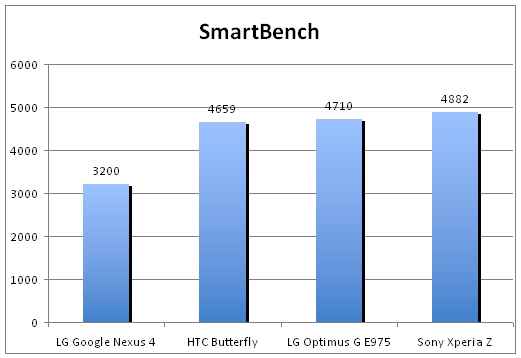 |
Rightware browsermark pushes the capabilities of the browser on the smartphone to its limits. The benchmark tests features such as how well the browser will resize screen, how fast the browser loads pages and send requests, if the browser support modern web site development techniques, and more. In our test, it seems that the LG Optimus G scored the least here whereas the winner was the Google flagship device, the Nexus 4.
Quadrant is a CPU, I/O and 3D graphics benchmark. The higher the score, the better optimized the smartphone is. Here, surprisingly the Nexus 4 scored the lowest whereas the Sony Xperia Z emerged the best. The scores of the LG Optimus G E975, HTC Butterfly and the Sony Xperia Z were quite close, whereas the Nexus 4 lagged behind.
The AnTuTu Benchmark tests the ‘Memory Performance’, ‘CPU Integer Performance’, ‘CPU Floating-point Performance’, ‘2D 3D Graphics Performance’, ‘SD card reading/writing speed’, ‘Database IO’ performance testing on the smartphone. Once again, the higher the score, the better. Here, the scores are quite close between all the four devices. We have the Sony Xperia Z with the lowest score and the LG Google Nexus 4 which scored the best.
Smartbench 2012 is a multi-core friendly benchmark application that measures the overall performance of your smartphone. It reports both productivity and gaming indices. Simply put, if you need to run games and heavy duty apps, then Smartbench score should help you decide the device for you. Here, the LG Google Nexus 4 scored the least whereas the scores of the other three smartphones was very close with the Sony Xperia Z emerging victorious.
GLBenchmark 2.5.1 is a graphics performance benchmark tool that measures different graphic and computation capabilities of your mobile device. The majority of the tests focus on graphic resources, measuring the quality and performance of the underlying OpenGL ES 2.x implementation. The score listed in the above benchmark is for the onscreen performance of the benchmark on the smartphone. The Sony Xperia Z with its 1080p display scored the least, whereas the LG Google Nexus 4 scored the most. Rendering graphics on a 720p display is easier for the hardware than the 1080p display; hence the two devices with 1080p displays scored less.
Build and Features on Offer:
Coming to the biggest distinguishing factors of the smartphones – the build and exclusive features these devices bear.
LG Optimus G
The LG Optimus G is LG’s latest flagship smartphone to hit the Indian shores. In its design, it is very reminiscent of the Nexus 4, except for its candy bar rectangular form factor, which with sharp edges, makes it uncomfortable to hold. It also has a unibody design, which means that the battery is inaccessible. The smartphone also doesn’t offer expandable storage, which means that you are stuck with what you get. The rear of the smartphone has a glass panel, a feature we were first introduced to with the iPhone 4. It also has a textured back beneath the glass panel. Al in all, the design and build of the Optimus G is good, but for its sharp edges.
In terms of the features on offer, LG has done quite a god job with the preloaded skin on the Optimus G. It has removed all the bloatware that was present on the skin a year ago. Instead, you have a slew of features that show off the multitasking capabilities and the power under the hood of the smartphone. You can have up to three apps open simultaneously – two in windows and one on the main screen. The drop down notification too gives you access to settings as well as your favourite apps. You can also group apps into folders not only on the home screen but also in the app listing page as well and many more features on offer.
It’s safe to say that the LG UI has a packed in enough features to give the likes of TouchWiz and the Sense UI a run for its money.
Sony Xperia Z
The Sony Xperia Z on the other hand has a slab design and has lost the ‘human curvature’ we have come to love from other Xperia smartphones. Even though the device has sharp edges, they don’t cut into your hands when you hold the smartphone. The biggest advantage of the Xperia Z is that it has the 1P57 (dust) and IP57 (water) resistance ratings. The ports of the smartphone are covered and the device can be submerged in shallow water and can withstand some torture in the rain. The Xperia Z too has a unibody design, which means that you don’t have access to the battery but you do have the option of expandable storage via a microSD card slot. The location of the power button rests in the centre of the side spine of the phone – not the most comfortable location.
In terms of its features, the Xperia Z has a skin overlaying Android. From the lock screen you can swipe anywhere to unlock the device. You also have quick access to the camera app from the lock screen. The UI of the smartphone, especially the theme, is very similar to what we saw on the Xperia S. True to Sony’s tradition, you also have access to apps such as Music Unlimited, Video Unlimited, and PlayStation Mobile. The PlayStation brand is pushed on Sony smartphones and users have access to a large library of Sony games.
The build of the Xperia Z smartphone may not appeal to all courtesy its weather-proof nature but if you are the outdoors-type, or clumsy near water-bodies, you might want to take a look at this device. The UI overlaying Sony’s smartphone has improved over the years. The Bravia engine does add to the display but even at 1080p it isn’t the best that we have seen.
HTC Butterfly
Next up we have the HTC Butterfly. Staying true to the tradition of HTC smartphones, the Butterfly has a polycarbonate unibody, giving it the feel of one of the most premium smartphones in your hands. The rubberized back of the smartphone adds to the grip making it one of the most comfortable smartphones to fit in our hands. Despite having a unibody design, the Butterfly offers user the option of expandable storage. The overall build of the HTC Butterfly feels better than most smartphones and you do get what you pay for. The Butterfly also has the IPX-5 water resistance rating but doesn’t compromise on the looks when compared to the Xperia Z. Even though the HTC Butterfly has a 5-inch display just like the Xperia Z, it feels more compact and comfortable to hold in ones hands. Single hand operation may be tough, but then again, all 5-inch smartphones are presumed to be used with two hands.
At first glance, the Sense UI overlaying Android seems to be the same as its predecessor and for the most part it is the same. Only HTC veterans will be able to notice the slight difference on the smartphone. You have access to four apps directly from the lock screen, which has always been a nice touch of the UI. The Sense UI still has the Leap view in which a user can pinch the home screen to see all the active home screens at once. There isn’t much utility here, but it is a nice feature to have nonetheless. Users can have as many as seven home screens on the HTC Butterfly. Just like the Optimus G, you can see all the home screens while adding widgets and shortcuts. This is essential especially if you are one who wants to add a lot of widgets and apps on the 7 home screens and wants a quick view to see what app or widget is where. The task swither/ multitasking menu is quite different from stock Android. The apps are listed in a cover flow format rather than a vertical list that we have on other smartphones.
All in all, the HTC Butterfly is one of the best-built smartphones that we have seen and the Sense UI is still one of those that you will love if you have used it before or hate if you didn’t like the previous iterations. The display of the smartphone needs a special mention here, as it is the best display we have seen on a smartphone till date.
LG Nexus 4
Last but not least, we have the Nexus 4. This is Google’s flagship smartphone and is made by LG. The Nexus 4 isn’t officially available in India but it is one smartphone that is worth the effort of importing, simply because of the price-performance ratio it offers. It has a curved design and feels extremely comfortable in ones hands. The rear of the smartphone has a glass back just like the Optimus G and below the glass panel is a textured design that shifts its glow when exposed to light. There is no utility to this but it looks gorgeous. The Nexus 4 has a unibody design, which means you don’t have access to the battery, and there is no expandable option either. Overall the Nexus 4 is one of the sexiest phones around and will definitely turn heads if you use it in public.
The biggest advantage of owning a Nexus smartphone is that you will be the first person to receive the Android update once Google releases it. The OS experience is rawest (or cleanest) there is, and if you are one who hates preloaded bloatware or skin, the Nexus 4 is the device for you. From the lock screen, users have access to unlock the smartphone, Google Now, a shortcut to the camera as well as any other app whose widget you’d like to have. The rest of the user interface is very simple and the most vanilla Android experience. If you want to add any bells and whistles to the Nexus 4, you have access to the large library of apps on offer in the Google Play store, and the many launchers for an overall interface change. The camera app is also excellent. You have access to all the major functions such as HDR, white balance, flash and more on a click wheel on the display.
Overall for the price you pay, the Nexus 4 is a fantastic smartphone. To maintain the 25k price point Google has cut corners and this will only be visible to the trained eye. The display, though gorgeous lacks vibrancy, especially when compared to the Optimus G. It has no LTE or microSD card support. The Nexus 4’s second biggest draw of course remains the assurance of the latest Android OS version (for at least a few iterations).
Camera Comparison
One of the biggest differentiators of smartphones, apart from the build and the exclusive software/hardware features, is the camera. If you are paying between Rs. 25,000 and Rs. 43,000 for a top-of-the-line smartphone, you should be assured of a decent imaging tool. Unfortunately, none of the four smartphones in question offer superlative performance.
If you are looking for a phone with a top-notch camera, you might have to look in the direction of Windows Phone and iOS, as currently, the Nokia Lumia 920 and Apple iPhone 5 are the best exponents for excellent imaging. Your choices are quite limited in the Android smartphone segment however, with perhaps HTC’s last generation flagship, the One X , offering the best optics.
Of the four smartphones in question however, Sony’s Xperia Z easily offers the best optics, with the HTC Butterfly trailing behind relatively closely. The LG Optimus G’s 13MP camera delivers slightly better results than the Nexus 4, though to be frank, both imaging systems are quite mediocre, at least for flagship devices.
Conclusion
To conclude we’d like to say that the flagship smartphones available in Indian the market today are all brilliant in their own ways. They all offer a set of unique features that sets them apart from one another, with high performance and a rich feature set the common denominators.
Battery life, a factor not discussed above, is similar for the four smartphones in question, with each offering roughly 1 day of battery life with above average use. When it comes down to just which smartphone to purchase, the decision is not too difficult. The most important factor is whether you like the build and the preloaded skin. After that, almost everything else falls into place.
One question does remain however, and if excellent optics is what you require, you might have to either look away from the current generation of Android devices, or even set your sights on other platforms all together.
What this also implies however, is that waiting slightly for the Samsung Galaxy S IV or HTC One, the next-generation of smartphones which should in all likelihood offer superior camera performance, might just be your best bet in the Android segment.
